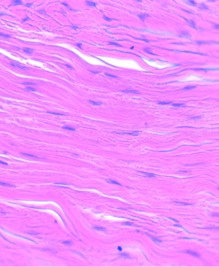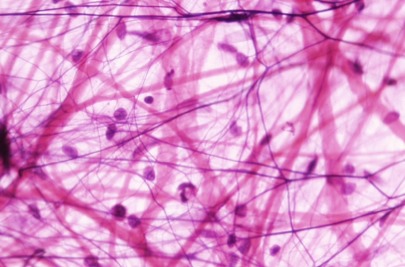Sign up for FlowVella
Sign up with FacebookAlready have an account? Sign in now
By registering you are agreeing to our
Terms of Service
Loading Flow


34. Connective tissue is found everywhere in the body and is the most abundant and widely distributed of the primary tissues. Mesenchyme is the first definitive tissue formed from the mesoderm germ layer. Mesenchyme os composed of star-shaped mesenchymal cells and a fluid ground substance containing fine fibrils. During the early weeks of embryonic development it arises and specializes into all other connective tissues. Some remain and provide a source of new cells in mature connective tissues. Mucous connective tissue is a temporary tissue derived from mesenchyme and similar to it. Connective tissue proper has two subclasses: the loose connective tissues (areolar, adipose, and reticular) and dense connective tissues (dense regular, dense irregular, and elastic). Areolar connective tissue's functions include supporting and binding other tissues, holding body fluids, defending against infection, and storing nutrients as fat. This serves as a kind of universal packing material between other tissues. It binds body parts together while allowing them to move freely over one another;wraps small blood vessels and nerves; surrounds glands; and forms the subcutaneous tissue, which cushions and attaches the skin to underlying structures. Adipose tissue is similar to areolar tissue in structure and function but its nutrient-storing ability is much greater. Adipocytes or fat cells account for 90% of this tissue's mass. Adipose tissue is richly vascularized and has high metabolic activity. Without the fat stores in our adipose activity, we could not live for more then a few days without eating. It makes up 18% of an average person's body weight. This tissue may develop almost anywhere but usually accumulates in subcutaneous tissue where it acts as a shock absorber and as insulation. It helps prevent heat loss from the body. Reticular connective tissue resembles areolar connective tissue, but the only fibers in its matrix are reticular fibers. These form a delicate network along which fibroblasts called reticular cells lie scattered. Reticular tissue is limited to certain sites, as it forms an internal framework that can support many free blood cells. Dense regular connective tissue is one variety of the dense connective tissues, all of which have fibers as their predominant element. The dense connective tissues are often referred to as fibrous connective tissues. Dense regular connective tissue contains closely packed bundles of collagen fibers running in the same direction. This tissue forms the tendons that attach muscles to other muscles or to bones. It also forms the ligaments that bind bones together at joints. Dense irregular connective tissue forms sheets in body areas where tension is exerted from many different directions. It is found in the skin and forms fibrous joint capsules and the fibrous coverings that surround some organs.


